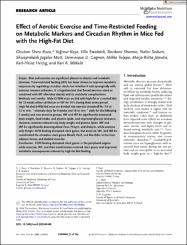| dc.contributor.author | Raza, Ghulam Shere | |
| dc.contributor.author | Kaya, Yağmur | |
| dc.contributor.author | Stenbäck, Ville | |
| dc.contributor.author | Sharma, Ravikant | |
| dc.contributor.author | Sodum, Nalini | |
| dc.contributor.author | Mutt, Shivaprakash Jagalur | |
| dc.contributor.author | Gagnon, Dominique D. | |
| dc.contributor.author | Tulppo, Mikko | |
| dc.contributor.author | Järvelin, Marjo-Riitta | |
| dc.contributor.author | Herzig, Karl-Heinz | |
| dc.contributor.author | Mäkelä, Kari A. | |
| dc.date.accessioned | 2024-03-29T13:06:58Z | |
| dc.date.available | 2024-03-29T13:06:58Z | |
| dc.date.issued | 2023 | en_US |
| dc.identifier.citation | Raza, G.; Kaya, Y.; Stenbäck, V.; Sharma, R.; Sodum, N.; Mutt, S. J.; Gagnon, D. D.; Tulppo, M.; Järvelin, M.; Herzig, K.; Mäkelä, K. A. Effect of aerobic exercise and time-restricted feedingon metabolic markers and circadian rhythm in mice fedwith the high-fat diet.
Molecular Nutrition & Food Research (2024), 68(5). | en_US |
| dc.identifier.issn | 1613-4125 | |
| dc.identifier.issn | 1613-4133 | |
| dc.identifier.uri | https://onlinelibrary.wiley.com/doi/10.1002/mnfr.202300465 | |
| dc.identifier.uri | https://doi.org/10.1002/mnfr.202300465 | |
| dc.identifier.uri | https://hdl.handle.net/20.500.12780/789 | |
| dc.description.abstract | Scope
Diet and exercise are significant players in obesity and metabolic diseases. Time-restricted feeding (tRF) has been shown to improve metabolic responses by regulating circadian clocks but whether it acts synergically with exercise remains unknown. It is hypothesized that forced exercise alone or combined with tRF alleviates obesity and its metabolic complications.
Methods and results
Male C57bl6 mice are fed with high-fat or a control diet for 12 weeks either ad libitum or tRF for 10 h during their active period. High-fat diet (HFD)-fed mice are divided into exercise (treadmill for 1 h at 12 m min−1 alternate days for 9 weeks and 16 m min−1 daily for the following 3 weeks) and non-exercise groups. tRF and tRF-Ex significantly decreased body weight, food intake, and plasma lipids, and improved glucose tolerance. However, exercise reduced only body weight and plasma lipids. tRF and tRF-Ex significantly downregulated Fasn, Hmgcr, and Srebp1c, while exercise only Hmgcr. HFD feeding disrupted clock genes, but exercise, tRF, and tRF-Ex coordinated the circadian clock genes Bmal1, Per2, and Rev-Erbα in the liver, adipose tissue, and skeletal muscles.
Conclusion
HFD feeding disrupted clock genes in the peripheral organs while exercise, tRF, and their combination restored clock genes and improved metabolic consequences induced by high-fat diet feeding. | en_US |
| dc.language.iso | eng | en_US |
| dc.publisher | Wiley | en_US |
| dc.relation.isversionof | 10.1002/mnfr.202300465 | en_US |
| dc.rights | info:eu-repo/semantics/openAccess | en_US |
| dc.subject | Circadian clocks | en_US |
| dc.subject | Exercise | en_US |
| dc.subject | Metabolic regulations | en_US |
| dc.subject | Obesity | en_US |
| dc.subject | Time-restricted feeding | en_US |
| dc.title | Effect of aerobic exercise and time-restricted feedingon metabolic markers and circadian rhythm in mice fedwith the high-fat diet | en_US |
| dc.type | article | en_US |
| dc.contributor.department | İstanbul Kent Üniversitesi, Fakülteler, Sağlık Bilimleri Fakültesi, Beslenme ve Diyetetik Bölümü | en_US |
| dc.contributor.authorID | https://orcid.org/0000-0003-3970-6417 | en_US |
| dc.contributor.institutionauthor | Kaya, Yağmur | |
| dc.identifier.volume | 68 | en_US |
| dc.identifier.issue | 5 | en_US |
| dc.relation.journal | Molecular Nutrition & Food Research | en_US |
| dc.relation.publicationcategory | Makale - Uluslararası Hakemli Dergi - Kurum Öğretim Elemanı | en_US |


















